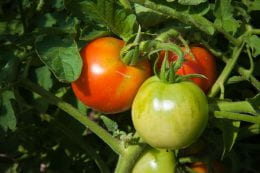
Many gardeners plant tomatoes and they are starting to ripen. Preserve them by canning, freezing or dehydrating to use later in many recipes. While it is fun to make salsa, spaghetti sauce or even a barbecue sauce, having basic options such as whole tomatoes, tomato juice or tomato sauce allows you to use tomatoes in many more recipes.
Here are some reminders about tomatoes:
- Although tomatoes are usually considered to be acidic in flavor, most have pH values slightly above 4.6, which makes them a low-acid food. As such, tomato products must be acidified to a pH of 4.6 or below with bottled
lemon juice, vinegar, or citric acid. Properly acidified tomatoes can be safely processed in a boiling-water canner or pressure canner as an acid food. Learn how to acidify tomatoes in Preserve it Fresh, Preserve it Safe: Tomatoes. - Pressure processing instructions are equivalent in heat treatment to water bath processing. Caution: Both methods require acidification. There are no recommendations for processing tomatoes without acidification. The chart in the above publication provides the options for acidification.
- Tomato-based recipes for products such as salsa, barbecue sauce, ketchup and others will also include added acid. Do not reduce the amount of added acid in these recipes.
- Tomatillos can be substituted for tomatoes in the same amount stated in a recipe, such as in salsa.
- Salt is for flavor only and can be omitted, if desired.
